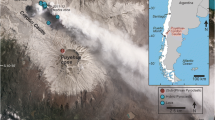Abstract
HCl:SO2 mass ratios measured by open path Fourier transform spectroscopy (OP-FTIR) in the volcanic plume at Soufrière Hills Volcano, Montserrat, are presented for the second phase of dome building between November 1999 and November 2000. HCl:SO2 mass ratios of greater than 1 and HCl emission rates of greater than 400 t day–1 characterise periods of dome building for this volcano. The data suggest that chlorine partitions into a fluid phase as the magma decompresses and exsolves water during ascent. This is substantiated by a correlation between chlorine and water content in the melt (derived from the geochemical analysis of plagioclase melt inclusion and matrix glasses from phase I and II of dome growth). The matrix glass from the November 1999 and March 2000 domes indicate an open system degassing regime with a fluid-melt partition coefficient for chlorine of the order of 250–300. September 1997 glasses have higher chlorine contents and may indicate a switch to closed system degassing prior to explosive activity in September and October 1997. The OP-FTIR HCl time series suggests that HCl emission rate is strongly related to changes in eruption rate and we infer an emission rate of over 13.5 kt day–1 HCl during a period of high extrusion rate in September 2000. A calculation of the HCl emission rate expected for varying extrusion rates from the open-system degassing model suggests a HCl emission rate of the order of 1–4 kt day–1 is indicative of an extrusion rate of between 2 and 8 m3 s–1. Monitoring of HCl at Soufrière Hills Volcano provide a proxy for extrusion rate, with changes in ratio between HCl and SO2 occurring rapidly in the plume. Order of magnitude changes occur in HCl emission rates over the time-scale of hours to days, making these changes easy to detect during the day-to-day monitoring of the volcano. Mean water emission rates are calculated to range from 9–24 kt day–1 during dome building activity, calculated from the predicted mass ratio of H2O:HCl in the fluid at the surface and FTIR-derived HCl emission rates.
Similar content being viewed by others
Author information
Authors and Affiliations
Corresponding author
Rights and permissions
About this article
Cite this article
Edmonds, M., Pyle, D. & Oppenheimer, C. HCl emissions at Soufrière Hills Volcano, Montserrat, West Indies, during a second phase of dome building: November 1999 to October 2000. Bull Volcanol 64, 21–30 (2002). https://doi.org/10.1007/s00445-001-0175-0
Received:
Accepted:
Published:
Issue Date:
DOI: https://doi.org/10.1007/s00445-001-0175-0




